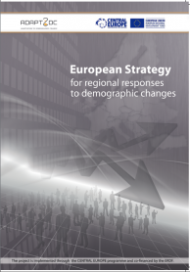Demographic change is one of the most important challenges for economically, socially and environmentally sustainable development in many regions of Central Europe. Population losses due to low fertility rates, migration and population ageing have already been experienced in many parts of regions, cities as well as some metropolitan areas. It is crucial to realize that population shrinkage and ageing is and will be important both for urban and rural areas in Central Europe. All forecasts state that these processes will continue for the next decades and will widen the gap between a prosperous core and a shrinking periphery all over Europe.
The aim of this European Strategy for regional responses to demographic changes as part of the ADAPT2DC – Adaptation to Demographic change project implemented within the Central Europe Programme was:
- to identify the risks and challenges for shrinking regions
- to provide an overview over positive regional solutions and practices and finally
- to give recommendations for regional actors on how to successfully and costeffectively respond to the threats those regions are facing.
As ADAPT2DC is a transnational inter-regional project, it has been decided to mainly address the regional level. The most important fields of political intervention we concentrated on were:
- Health care
- The provision of social services
- Transport and mobility
- Public buildings and housing
- Other technical infrastructure
One common challenge for all fields of public infrastructure and service provision taken into account is the problem of securing the existing level of services in the face of a shrinking and ageing society. As a consequence, less public income per capita is available. The decreased fi nancial potential hits low-density areas worst as in many cases they have already suffered from poor supply and economic inefficiencies. Citizens from low-density areas may face a higher risk of social exclusion. Other common challenges in many public policy fields include higher expectations due to a changing societal demand. The mere securing of the staus quo is insufficient in many cases. Often regions should do better than now to improve living conditions and thus contribute to their own stabilisation for interregional competition.
The overview of good regional practices shows that, in fields taken into consideration by the project, many good solutions already exist. Many regions – within and outside of Central Europe – have already gained experience with demographic change and reacted to it in an exemplary manner. With respect to their transferability, these good and successful practices constituted, in many cases, grounds for the policy recommendations given in this Strategy. However, they should be disseminated more widely among the Central European policy makers.
The recommendations provided by this European Strategy should be treated as an inspiration for actions by authorities at various levels , mostly regional and local, and seen in short, medium, and long perspectives.
The challenge for health care is chiefly associated with population ageing and methods for securing the growing demand for health care services for increasingly older inhabitants. In order to support the healthcare sector new, innovative, and technologically advanced methods could be used mainly to decrease costs of providing health care services. Besides, there is a need to attract medical staff to work in this sector, especially in rural and low-density areas.
The challenge for providing social services is to manage providing them at an adequate level of quality adjusted to the needs of inhabitants, especially in shrinking areas with decreasing population and demographic imbalance. The recommended solutions advise regions to utilise the resources of the civil society (involving voluntary work) to diversify financing of the needed services. Flexible and combined organisations can preserve the quality of the supply system, and provide responsive social care services.
The challenges for transport and mobility lie in the provision of public transport in low density areas for inhabitants. Successful and recommended solutions for regions consist, above all, in integrated public transport planning on a regional scale, the bundling of demand of different user groups, flexible and demand-responsive public transport in areas of very low demand, and finally the encouragement of civil and/or market-driven solutions.
Challenges within the scope of public buildings and housing are related to several problems. Firstly – the reduction of operating costs of managing public buildings. Th is problem can be solved, for example, through the multiple use of existing infrastructure or by carrying out energy audits of public buildings. Secondly – adapting the current housing to the needs of the elderly. It is recommended to use preliminary measures such as barrier-free housing or the provision of sustainable health and social services.
In regions affected by demographic change, the challenge for the management of technical infrastructures in the fields of water, sewage and energy principally lies in the implementation of new management solutions that guarantee their availability in the condition of economic convenience for the society and service providers. Above all, in declining rural and isolated areas, existing large infrastructures such as water pipelines and sewers, electric networks, power stations and plants, etc. face the risk of under-utilisation, which eventually determines obsolescence and increasing costs for users and providers. These trends can be mitigated by cost-saving solutions to be pursued by decisions of territorial planning and management, cooperative agreements among operators, and the development of a more decentralised system of units, operators, and channels.


Newsletter
Facebook
X
Tweets by SociologickyNewsletter